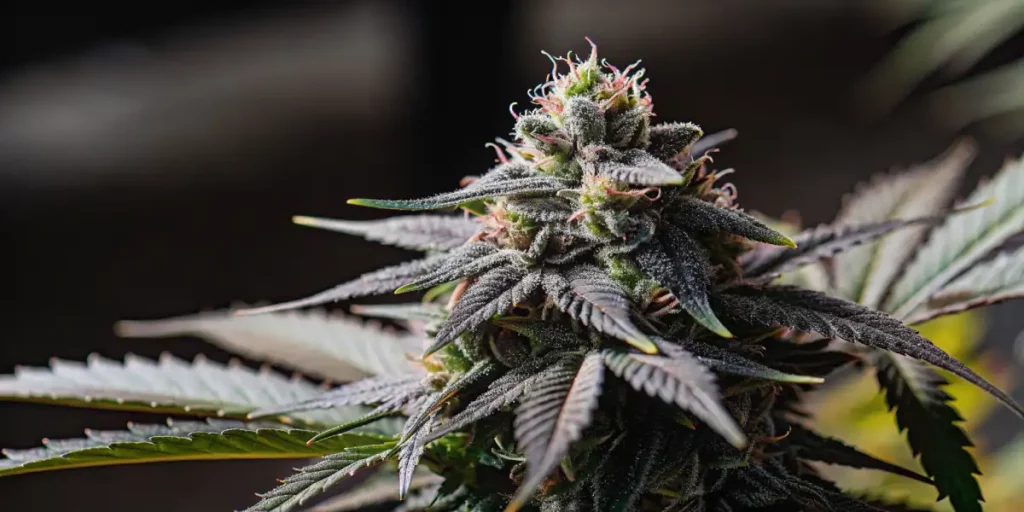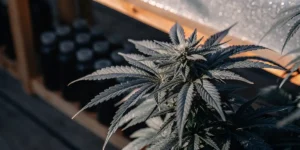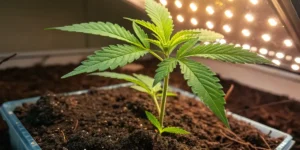Growing Critical Kush Auto, an auto-flowering strain known for its resilience and high yield, is a rewarding endeavor for both novice and experienced cultivators. This strain is a cross between Critical Mass and OG Kush, offering both a robust growth pattern and a potent final product. Being an auto-flowering variety, it automatically transitions from the vegetative to flowering stage, usually taking around 10-12 weeks from germination to harvest. With its ability to thrive in various conditions, it’s ideal for those looking to cultivate cannabis with minimal fuss.
To start the cultivation process, select your growing medium—this can be soil, coco coir, or a hydroponic system. The choice largely depends on your resources and experience. Soil is the simplest and often used by beginners, whereas hydroponic systems require more expertise. Ensure that your medium is rich in nutrients, as the plant thrives on a steady supply of essentials like nitrogen, phosphorus, and potassium. Proper nutrient balance is crucial during the vegetative phase to promote healthy leaf development and strong stems.
Lighting is a critical element in the growth of any autoflowering strain. Given its auto-flowering nature, it’s less dependent on strict light cycles than photoperiod strains, but robust lighting will enhance growth and yield. Equip your indoor grow space with LED or HID lights, maintaining a cycle of about 18–24 hours of light daily. However, monitor plant health and development to adjust light duration if necessary, keeping temperatures stable between 20–25°C (68–77°F) to avoid stress that could hinder progress.
Proper watering and humidity control are essential for healthy plant development. Overwatering is a common mistake—ensure your medium drains well and only water when the top layer feels dry. Maintain humidity levels around 40–50% during the vegetative stage, reducing slightly to about 30–40% during flowering. This helps prevent mold and enhances resin production, a hallmark of potent strains.
As the plant transitions to flowering, typically around weeks 4 to 5, you’ll need to shift the nutrient balance toward higher phosphorus and potassium levels. Monitoring bud development is important—look for density and aroma as signs of healthy growth. In the final week, consider flushing with pure water to eliminate nutrient residues and ensure a smoother, more flavorful smoke after harvest.
With careful attention and optimal conditions, yields can reach up to 450–550 grams per square meter indoors. Compact size, resin-rich buds, and a strong aromatic profile make this strain a favorite among growers. Harvesting at the right time—when trichomes are milky with hints of amber—ensures you capture peak potency. Successfully growing an autoflower like this provides a high-quality yield and valuable experience in cannabis cultivation.
Critical Kush Auto Strain Overview: Traits, Effects & Genetics
Critical Kush Auto is a formidable player in the world of autoflowering cannabis strains, successfully merging the rich lineage of Critical Kush with the ease and convenience of an autoflowering variety. This strain is known for its robust growth, making it an excellent option for both novice and experienced growers. It typically reaches a medium height, suitable for discreet home cultivation while still producing a generous yield. The plant showcases dense, resinous buds that are a testament to its potent heritage, exuding a deep and inviting aroma.
The aroma and flavor profile of this strain is a compelling combination of earthy and pine notes, often accompanied by hints of citrus and spice that make each session a sensory delight. These aromatic compounds not only offer a pleasurable experience but also hint at the powerful effects the strain can produce. The bud’s visual appeal is noticeable, characterized by rich green hues and abundant trichomes, which add a frosty appearance suggestive of its high THC content.
Genetically, this variety draws from Critical Mass and OG Kush, infusing potent indica effects with a modern autoflowering twist. This genetic mixture results in a plant that flowers swiftly—typically within 8 to 10 weeks—without requiring changes in light cycles, thus offering a speedier alternative to traditional photoperiod strains. Its genetics ensure resilience against environmental stressors, making it an ideal strain for various growing conditions, be it indoor, outdoor, or greenhouse environments.
In terms of effects, the strain carries a predominantly indica profile, delivering deeply relaxing sensations that can ease both physical tension and mental stress. It’s particularly favored for its ability to induce tranquility and a sense of well-being, often leading to a restful night’s sleep. Additionally, its high THC levels make it effective for pain relief and anxiety reduction. While the effects are powerful, they are also smooth, ensuring a soothing experience without overwhelming the user.
Optimal Environment to Grow Critical Kush Auto Successfully
Creating the ideal environment for cultivating Critical Kush Auto can significantly impact the yield and quality of your harvest. This autoflowering strain, known for its resilience and potent effects, thrives when specific conditions are met. The aroma and flavor profile of this strain is a compelling combination of earthy and pine notes, often accompanied by hints of citrus and spice that make each session a sensory delight. These aromatic compounds not only offer a pleasurable experience but also hint at the powerful effects the strain can produce. The bud’s visual appeal is noticeable, characterized by rich green hues and abundant trichomes, which add a frosty appearance suggestive of its high THC content.
Genetically, this variety draws from Critical Mass and OG Kush, infusing potent indica effects with a modern autoflowering twist. This genetic mixture results in a plant that flowers swiftly—typically within 8 to 10 weeks—without requiring changes in light cycles, thus offering a speedier alternative to traditional photoperiod strains. Its genetics ensure resilience against environmental stressors, making it an ideal strain for various growing conditions, be it indoor, outdoor, or greenhouse environments.
In terms of effects, the strain carries a predominantly indica profile, delivering deeply relaxing sensations that can ease both physical tension and mental stress. It’s particularly favored for its ability to induce tranquility and a sense of well-being, often leading to a restful night’s sleep. Additionally, its high THC levels make it effective for pain relief and anxiety reduction. While the effects are powerful, they are also smooth, ensuring a soothing experience without overwhelming the user.
Grow Room Setup for Critical Kush Auto Plants
Setting up an optimal grow room for Critical Kush Auto plants is essential for maximizing yield and ensuring plants achieve their full genetic potential. Due to its autoflowering nature, this strain is less reliant on light cycle changes, making it easier for novice growers. Begin by selecting a suitable location that offers enough space for your expected number of plants. Ensure the area has proper ventilation to facilitate fresh airflow, which helps maintain optimal temperature and humidity levels. For those starting from seed, it’s important to understand how long does a cannabis seed take to sprout, as early environmental control is key to successful germination and strong seedling development.
Lighting is a crucial component for growing autoflowering cannabis. These plants flourish under full-spectrum LED lights or high-intensity discharge (HID) lighting systems. Aim for 18–24 hours of light per day to support healthy development. Position lighting fixtures strategically, maintaining a safe distance from plant canopies to prevent light burn without compromising light intensity. Employing adjustable light hangers allows you to reposition lights as plants grow taller, ensuring they’re consistently receiving adequate illumination.
Temperature and humidity control plays a fundamental role in maintaining plant health. These plants thrive in temperatures ranging from 70–80°F (21–27°C) during the day and slightly cooler conditions at night. Use hygrometers and thermometers to regularly monitor environmental conditions, adjusting as necessary with fans, air conditioning, or heaters. Likewise, keep relative humidity levels around 40–50% to prevent mold and mildew, particularly during the flowering stage when plants are more susceptible to moisture-related issues.
Invest in quality grow media that provides ample drainage and aeration, such as coco coir or a soil-perlite mix. Autoflowers benefit from a rich nutrient regimen balanced with macronutrients like nitrogen, phosphorus, and potassium alongside essential micronutrients. Automated watering systems or manual feeding can be utilized, but be cautious of overwatering, which could lead to root rot. Ensure your grow pots have sufficient drainage holes to allow excess water to escape, further promoting a healthy root environment.
Lastly, outfitting your grow room with reflective materials such as Mylar or Panda film can help maximize light efficiency by reducing wasted light energy. Consider setting up a SCROG (Screen of Green) netting system if space is a constraint, allowing you more control over plant shape and structure while optimizing your grow space. By attending to each of these elements with care, your plants will have the foundation to thrive, rewarding you with resilient growth and bountiful harvests.
Indoor Growing Tips
Growing Critical Kush Auto indoors can be an enriching experience, provided the right conditions and care are meticulously maintained. This strain, known for its remarkable resilience and potent effects, thrives in controlled environments. Start with a high-quality grow space such as a grow tent, which allows for optimal control over environmental conditions. Ensure your tent is equipped with high-intensity LED lights to provide the 18 to 20 hours of light per day that autoflowering strains prefer. Proper lighting is crucial as it directly affects the photosynthesis process, contributing to robust growth.
Controlling the temperature and humidity is crucial when growing autoflowering cannabis strains indoors. These plants prefer mild conditions, with temperatures ranging between 70–78°F (21–25°C) during the day and slightly cooler at night. Humidity levels should be decreased as the plant matures; keep it around 60% during the vegetative stage and gradually reduce it to 50% during flowering. Air circulation is equally important; using oscillating fans can prevent mold and mildew by ensuring that air circulates evenly around the plants.
This type of strain typically demands nutrient-rich soil or hydroponic solutions to maximize yield potential. Use pre-fertilized soil or a quality nutrient solution designed for cannabis to provide all the essential nutrients, which include nitrogen, phosphorus, and potassium. Ensure pH levels remain between 6.0 and 6.5 for soil, and slightly lower for hydroponics, around 5.5 to 6.0, to allow for optimal nutrient uptake. Regular monitoring and adjustment ensure the plant absorbs nutrients effectively, contributing to vigorous growth and potent buds.
Since this is an autoflowering variety, it progresses rapidly through its life cycle. Pruning is generally not recommended for autos as it can stress them; instead, focus on low-stress training (LST) techniques to enhance light distribution and promote an even canopy. These strains often have inherent resistance to common pests and diseases, easing the grower’s workload, though routine inspections are advisable to catch any potential issues early. With attentiveness and precision, indoor cultivation of autoflowers can be both manageable and highly rewarding.
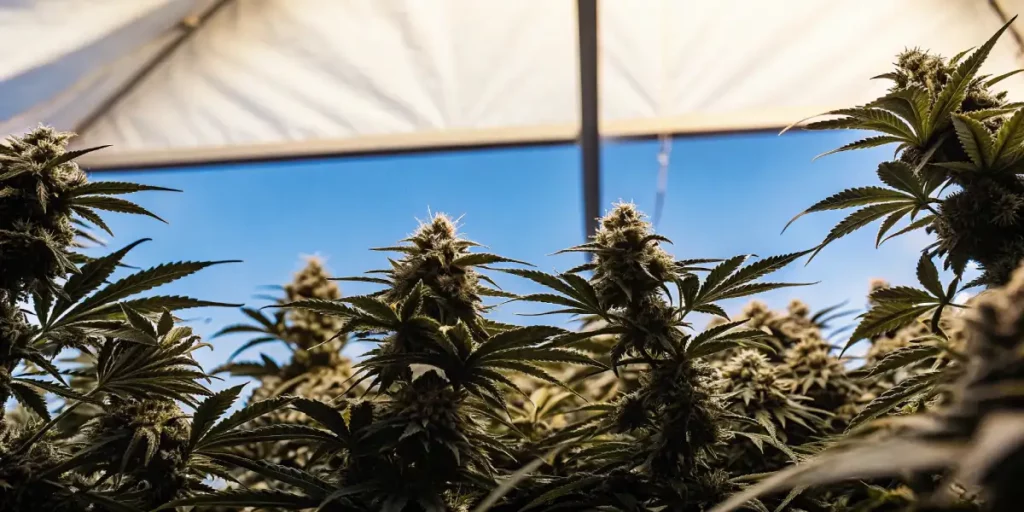
Outdoor Growing Tips
Growing Critical Kush Auto outdoors can be a rewarding endeavor due to its robust growth capabilities and resilience. One of the first things to consider is your climate. This strain thrives in temperate to warm climates, so if you live in an area with long, sunny days, your plants will flourish. However, if your region is prone to cooler temperatures or significant rainfall, consider using a greenhouse or setting up protective coverings to shield your plants from harsh weather conditions.
When selecting a site for your plants, make sure it receives plenty of direct sunlight each day, as light is essential for robust growth and maximum yield. Ideally, your location should provide at least 8 hours of sunlight. Space your plants appropriately to ensure adequate airflow between them, which not only reduces the risk of mold but also encourages stronger plant structure. Proper spacing is particularly important for auto-flowering strains, which require optimal conditions for their quick growth cycle.
Soil quality is another critical factor. These plants benefit from well-draining soil rich in organic matter. Consider amending your soil with compost or pre-made cannabis super soil to provide the necessary nutrients throughout the growing cycle. Regularly check soil pH levels (ideally between 6.0 and 7.0) to ensure nutrient availability and adjust as necessary using pH up or down solutions. Additionally, keeping the soil consistently moist is vital, but avoid overwatering, which can lead to root rot.
While this strain is known for its hardiness, it’s still important to monitor for pests and diseases. Implement proactive measures such as companion planting with marigolds or basil, which can naturally deter common pests like aphids and caterpillars. Using organic pesticides and fungicides can also help manage and prevent infestations. Regular checks for signs of stress or disease should be conducted to catch any issues early, ensuring healthy growth and bountiful harvest.
How to Germinate & Propagate Critical Kush Auto
Germinating Critical Kush Auto is a crucial step towards a successful cultivation journey, as the process sets the foundation for robust plant development. Begin by gathering high-quality seeds, preferring those from reputable suppliers to ensure optimal genetic traits. To start, the paper towel method is often recommended for its simplicity and effectiveness. Place your seeds between two damp paper towels, ensuring they are moist but not overly wet to avoid potential mold growth. Secure them between two plates or in a zip-lock bag, and position them in a warm, dark area, such as a cupboard or closet, maintaining a steady temperature between 70-85°F (21-29°C).
Check the seeds regularly over the next 24-48 hours. You should begin to see them crack open, with tiny taproots emerging, signaling successful germination. Once the roots have reached approximately a quarter to half an inch in length, they are ready for planting. Transfer the sprouts carefully to small pots filled with quality potting soil or a suitable growing medium designed for cannabis. Plant them root-down about half an inch into the soil. Be gentle during this process to avoid damaging the delicate root structures, and ensure that the soil remains consistently moist.
This strain is known for its resilience and rapid growth, making proper propagation equally significant. As an autoflowering variety, it naturally transitions from the vegetative phase to flowering without requiring changes in the light cycle, simplifying propagation. Place the pots in an environment with sufficient light, preferably utilizing LED grow lights or placing them near a sunny window indoors. Ensure the environment remains warm and maintains good air circulation. Regularly monitor moisture levels, temperature, and humidity, adjusting them as necessary to mimic ideal growing conditions, thereby fostering healthy propagation and robust plant development.
Continuing careful monitoring and maintenance during the propagation phase is key to cultivating a healthy crop. As the plant grows, consider repotting if space becomes limited or if nutrient uptake appears compromised. This strain is generally low-maintenance, thriving with minimal intervention, but maintaining vigilance for signs of stress or nutrient deficiencies is vital. Ultimately, knowing and mastering the nuances of germinating and propagating this strain can lead to a rewarding experience, yielding a robust harvest of high-quality cannabis.
Vegetative Stage: Nurturing Your Critical Kush Auto Plants
The vegetative stage is a crucial period in the life cycle of your Critical Kush Auto plants, where the focus is on developing a strong root system and lush foliage. This phase is all about laying the foundation for a healthy and prolific flowering stage. Each decision you make during this time impacts the growth and future yield of your cannabis plants. Being an autoflowering variety, this strain typically spends a shorter time in the vegetative stage compared to photoperiod strains, so maximizing the growth environment is essential.
Lighting plays a vital role during the vegetative stage, providing the energy necessary for photosynthesis. It’s recommended to maintain at least 18 hours of light per day. You can use either LED or fluorescent lights, ensuring they are kept at an appropriate distance to avoid burning the leaves while providing sufficient illumination. Adjust the light intensity as your plants grow taller and their light requirements increase. Alongside lighting, ensure your plants receive consistent water, but be cautious not to overwater, as this can lead to root rot and other water-related stressors.
Nutrients are another fundamental aspect of nurturing autoflowers during the vegetative phase. A well-balanced nutrient solution high in nitrogen will support robust foliage development. It’s crucial to follow the manufacturer’s guidelines on dosing to avoid nutrient burn, which can damage your plants. Additionally, maintain proper pH levels in your growing medium; for soil, a pH of 6.0–7.0 is ideal, whereas a hydroponic setup might require a slightly lower range. Regular monitoring can prevent nutrient lockout and ensure your plant’s health is not compromised.
Lastly, consider the benefits of implementing a gentle air circulation system around your plants. Good airflow helps to strengthen stems, improve transpiration, and reduce the risk of mold and pest infestation. A small oscillating fan can suffice, providing a gentle breeze that mimics natural wind conditions. Paying attention to these critical factors during the vegetative stage will help you nurture strong, healthy plants that are primed for an outstanding flowering period, ultimately leading to a satisfying and plentiful harvest.
Flowering critical kush auto: What to Expect
When cultivating Critical Kush Auto, growers can anticipate an efficient and rewarding flowering period, typically completing the cycle in approximately 8 to 9 weeks. This strain, beloved for its resilience and robust genetics, can thrive in a variety of growing conditions, making it an excellent choice for both novice and experienced cultivators. During the flowering phase, these autoflowering cannabis plants exhibit a rapid growth spurt, allowing for maximum yield in a condensed timeframe.
As flowering progresses, cultivators will observe the development of dense, resin-coated buds. These buds exude a pungent yet appealing aroma, characterized by earthy and spicy undertones coupled with a subtle hint of citrus. It is crucial during this period to maintain optimal environmental conditions, as fluctuations in temperature or humidity can impact resin production and overall bud quality. Ensuring good airflow and regular monitoring can aid in preventing mold or pest issues.
Cultivators should also anticipate and prepare for the distinctive physical traits of this strain during flowering. It tends to develop a compact and bushy structure, which contributes to its ability to support thick, weighty buds without requiring much additional support. It’s advisable to perform light trimming or low-stress training techniques to enhance light penetration and air circulation, thus promoting more uniform development throughout the plant.
The transition to harvesting following flowering involves watching for key maturity indicators, such as the changing color of pistils and trichomes. Typically, harvesting can commence once the pistils darken to an amber hue and trichomes become milky. The final product is a testament to patience and care, often delivering a high-quality yield of potent cannabis celebrated for its soothing and relaxing effects.
Fertilizers & Nutrient Schedule
Feeding Critical Kush Auto properly is essential to maximize its potential yield and potency. This autoflowering variety requires a balanced approach to nutrient application due to its relatively short lifecycle. Unlike photoperiod strains, autoflowers transition from the vegetative stage to flowering without a change in light cycle. Consequently, nutrient schedules must be adapted for a seamless transition to support both stages effectively. Knowing the specific nutrient needs of the plant at each growth phase is critical.
During the vegetative stage, the plant requires a higher concentration of nitrogen to aid in leaf and stem development. Beginning in this stage, use a well-balanced nutrient solution high in nitrogen along with essential microelements such as iron, magnesium, and calcium. A ratio of 3-1-1 NPK (Nitrogen-Phosphorus-Potassium) is often recommended to foster healthy vegetative growth. It is important to monitor the pH level of the soil or hydroponic solution, keeping it between 6.0 and 7.0 to ensure optimal nutrient uptake.
As the plant enters the flowering stage, it’s crucial to adjust the nutrient ratio to enhance bud formation. Reducing nitrogen and increasing phosphorus and potassium is vital during this phase. A ratio of 1-3-2 NPK can be quite effective at this stage. Phosphorus is integral for the development of flowers, while potassium contributes to stronger plants and enhanced flower quality. Carefully transition the feed to avoid nutrient lockout, which can occur if changes are too abrupt.
Maintaining an appropriate nutrient schedule is critical, but it’s equally important to avoid overfeeding. Autoflowering plants are often more sensitive to nutrient excess than photoperiod plants. Start with half the recommended dosage of nutrients and gradually increase as the plant demonstrates its tolerance. Regularly flush the growing medium with pH-balanced water to prevent salt buildup, which can lead to nutrient burn and adversely affect plant health. Consistent monitoring and adjustment are key to a successful harvest.
Pest and Disease Prevention for Healthy Cannabis Plants
Growing Critical Kush Auto successfully requires vigilant pest and disease management to ensure robust plant health and optimal yields. These cannabis plants, with their autoflowering genetics, have a distinct growth cycle that can be vulnerable to various pests and diseases if not properly managed. Establishing a preventative regime is crucial in maintaining the health of your plants throughout their growth stages. Begin by selecting quality seeds from reputable sources, as starting with healthy genetics minimizes initial vulnerability.
Creating an environment that discourages pests and diseases is a proactive step every grower should take. Plants thrive in conditions that provide adequate airflow and humidity control, crucial factors in fungal disease prevention. Ensure that your grow area is equipped with ventilation systems to maintain air circulation, and regularly monitor humidity levels, keeping them between 40–50% during the flowering stage. This environment not only supports healthy plant growth but also deters common pests such as spider mites and aphids, which thrive in stagnant, humid environments.
Natural pest control methods form an integral part of effective pest management. Introducing beneficial insects such as ladybugs or predatory mites can help control pest populations by naturally preying on them. Implementing companion planting with plants like basil or marigold can repel certain unwanted pests through their natural aromatic properties. Besides, regular inspection of plants for signs of pest activity or disease symptoms is essential; this allows for early detection and treatment, preventing infestations from escalating and spreading uncontrollably.
Besides to natural methods, employing organic pest control sprays can support your prevention strategy without disrupting the plant’s natural ecosystem. Products containing neem oil or insecticidal soap are effective against common pests and are safe for use on autoflowering strains. When applying any treatment, always follow the manufacturer’s instructions to prevent adverse effects on plant health. By integrating these measures into your cultivation practice, you’ll foster a resilient grow environment that minimizes pest and disease threats, ensuring your plants flourish.

Harvesting & Drying Critical Kush Auto the Right Way
When it comes to harvesting Critical Kush Auto, timing is crucial to maximize the potency and flavor of your yield. Typically, this strain is ready to harvest in around 10-12 weeks from germination. The best time to harvest is when the trichomes have turned from a clear to a milky white, with some shifting to amber. This indicates the peak balance of THC content and psychoactive effect. It’s essential to check your plants regularly as this window can change quickly, especially in the final weeks of growth.
The drying process is equally important and can greatly influence the overall quality and taste of your final product. Start by trimming the larger fan leaves and cutting the plants at the base. Hang the branches or whole plants upside down in a dark, well-ventilated room at a temperature of 60-70°F (15-21°C) and a humidity level of 45-55%. This environment helps prevent mold and allows your buds to dry slowly over a 10 to 14-day period, retaining terpenes and cannabinoids.
After the initial drying stage, it’s time to cure your cannabis buds. Place the dried buds in airtight glass jars, filling them to about 75% capacity to allow some air exchange. Store these jars in a cool, dark place, opening them daily for the first week to enable moisture to escape and fresh air to circulate. This process not only enhances the potency and flavor but also smooths out the smoke. Continue this curing process for at least two weeks, although longer curing times can improve quality further.
By harvesting at the right moment and applying meticulous drying and curing methods, growers can ensure that their Critical Kush Auto maintains its robust flavor profile and potent effects. Properly dried and cured buds will provide the smooth, relaxing experience that this strain is known for, making your hard work and patience worthwhile in the end.
Strain Type: Indica, Sativa or Hybrid?
This revered strain in the cannabis community is known for its rich lineage and balanced genetic profile. Primarily categorized as an indica-dominant hybrid, it combines the soothing serenity of indica with the stimulating creativity of sativa. Its genetic roots trace back to the original Critical Mass and OG Kush, both recognized for their potent indica characteristics. This lineage implies that the strain inherits a significant portion of its profile from indica ancestors, presenting an experience that is deeply relaxing and calming.
While it’s predominantly an indica strain, its hybrid nature should not be underestimated. The hybridization process introduces subtle sativa characteristics, enhancing its versatility and appeal. This presence of sativa genetics can manifest in short bursts of energy and creativity before the typical indica effects come to the forefront. Cultivators and users alike appreciate this blend because it provides a unique opportunity to experience a full-bodied high that doesn’t solely focus on relaxation but also teases with mental stimulation.
Growers favor this strain not only for its robust growth traits but also for its adaptable nature, which reflects its hybrid genetics. Its resilience and relatively rapid flowering period are significant, particularly for those cultivating in varied climates or conditions. Whether you’re an experienced grower or a novice, knowing the strain type gives insight into its growth patterns and the kind of environment it flourishes in. This blend of indica dominance with hints of sativa provides a rewarding experience both in the garden and post-harvest.
Why Grow Critical Kush Auto? Key Benefits for Cultivators
Critical Kush Auto is a highly sought-after strain in the world of cannabis cultivation, prized for its numerous benefits that appeal to both novice and experienced growers. One of the primary advantages of growing this strain is its robust auto-flowering trait, which significantly simplifies the cultivation process. By not relying on specific light cycles to initiate the flowering phase, it offers a more forgiving option for those who may not have the luxury of managing complex lighting schedules. This quality also translates to a faster turnover, meaning cultivators can enjoy multiple harvests within a single growing season.
Moreover, this variety is renowned for its resilience and adaptability. It exhibits strong resistance to common pests and diseases, a trait that can considerably reduce the stress and labor typically associated with maintaining plant health. This inherent robustness makes it an ideal choice for outdoor cultivation in various climates, from milder seasonal conditions to more unpredictable environments. Consequently, cultivators can benefit from high-quality yields without the need for an extensive toolkit of pest control products and interventions.
A significant factor in the growing appeal of this auto-flowering strain is its impressive yield and potent effects. Despite its automatic flowering nature, which can sometimes result in smaller harvests, it stands out by producing generous yields of dense, resin-coated buds. This, combined with its high THC content, assures a powerful, relaxing effect that is highly appreciated both recreationally and medicinally. The ease of obtaining such high-quality products with relatively low effort and investment makes it a lucrative option for cultivators seeking high returns on their harvest.
Potential Challenges When Growing Critical Kush Auto
Growing autoflowering cannabis varieties poses a unique set of challenges that cultivators must be prepared to face. One of the primary issues is their sensitivity to environmental changes. Because these strains transition through their life cycle faster than photoperiod variants, any adverse impact—such as fluctuations in temperature or humidity—can quickly affect growth and yield. Maintaining a consistent grow environment is critical, which may necessitate investment in suitable equipment such as automated climate control systems to stabilize indoor conditions and maximize potential.
Moreover, nutrient management can be particularly challenging due to the plant’s fast growth cycle. Autoflowers have less recovery time from nutrient deficiencies or excesses compared to other strains. An imbalance in nutrients can stunt growth or lead to nutrient burn, affecting overall yield and quality. Growers must be vigilant in their feeding regimes, tailoring them to the specific needs of autoflowering strains and adjusting nutrient concentrations based on the plant’s growth stage. Adopting a “less is more” approach often works well, starting with lower nutrient concentrations and gradually increasing as necessary.
Another challenge is managing the plant size and ensuring adequate light penetration throughout the grow. Despite being an autoflowering variant, these plants can still grow substantially, and without proper training or topping techniques, the lower branches might not receive sufficient light. This can lead to poor bud development in shaded areas. Techniques such as low-stress training (LST) can help spread the plant’s canopy, allowing more ample light distribution and healthier lower branches. Monitoring and adapting these techniques as the plant grows can be crucial to maximizing yield.
Additionally, pest management remains a critical challenge for growers. The faster growth cycle of autoflowering strains might leave less time to react to infestations, making preventative measures all the more vital. Regular inspections and the use of insecticidal soaps or neem oil as a preventive measure can help ward off common pests. Growers should also ensure that their grow space is clean and free from debris where pests might thrive. Integrated pest management practices can be a prudent investment to ensure the plants remain pest-free throughout their life cycle.
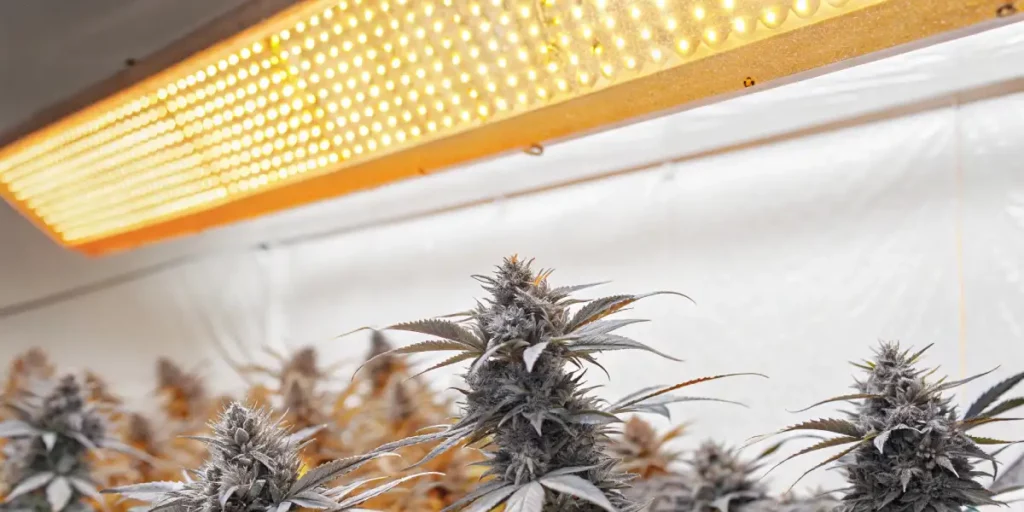
Is Critical Kush Auto Worth Buying? Here’s What You Need to Know
When considering whether to invest in Critical Kush Auto seeds, one must first understand the myriad benefits this strain offers. A hybrid that combines the best traits of Critical Mass and OG Kush offers a blend of robust growth, impressive yields, and a potent cannabinoid profile. This autoflowering variety is particularly attractive because it transitions from the vegetative phase to the flowering phase without the need for a change in light cycles, making it an ideal choice for both novice and experienced cultivators.
The convenience and rapid growth cycle of this strain cannot be overstated. It tends to flower and be ready for harvest within approximately 10 weeks, which is relatively fast compared to traditional photoperiod cannabis strains. This quick turnaround allows for multiple harvests in a single growing season, providing a steady supply for personal use or small-scale cultivation projects. Additionally, its compact size makes it well-suited for indoor grows or confined spaces, offering discretion and adaptability to various growing conditions.
Beyond its growth characteristics, this strain is celebrated for its potent effects and rich aromatic profile. Exhibiting a classic Indica dominance, it delivers a profoundly relaxing experience, making it popular among users seeking relief from stress and insomnia. Notes of earthy pine and citrus in its aroma not only make the cultivation process enjoyable but also promise a delightful smoking or vaping experience. Therefore, if you’re searching for a high-yielding, fast-growing, and potent cannabis strain, this variety certainly merits consideration.
While the benefits are evident, prospective growers should reflect on a few considerations. The autoflowering nature of the plant means it is less forgiving in terms of nutrient availability and environmental changes. Being a compact plant, it may yield slightly less than comparable photoperiod strains. Evaluating your growing environment and personal needs will ultimately guide your decision. In summary, for those seeking efficiency, potency, and ease of growth, this strain is undoubtedly a worthwhile investment.
FAQs
What is Critical Kush Auto?
Critical Kush Auto is an autoflowering cannabis strain derived from the popular Critical Kush, which is a hybrid of Critical Mass and OG Kush. This auto-flowering version combines desirable traits of its predecessors, like high THC levels and potent effects, while offering a shorter growth cycle. It is advantageous for growers looking for a quick harvest with minimal light cycle management, as it flowers automatically after a certain period.
How long does it take for Critical Kush Auto to grow from seed to harvest?
Critical Kush Auto typically takes around 8 to 10 weeks from seed to harvest. This short growth cycle makes it a popular choice for growers who desire a quick turnaround. The autoflowering nature means it transitions from the vegetative phase to the flowering phase automatically, regardless of light schedule, which can be beneficial for beginners and those growing in less controlled environments.
What are the ideal growing conditions for Critical Kush Auto?
Critical Kush Auto thrives best in a controlled environment with sufficient light, although it can be grown both indoors and outdoors. Indoors, maintaining a consistent temperature range between 70°F and 85°F and a humidity level of 40-50% during the flowering stage is ideal. Proper nutrients and soil should be used to ensure potent, high-yielding harvests. Outdoors, areas with warm climates and long sunny days are preferable.
What are the effects and benefits of consuming Critical Kush Auto?
Consuming Critical Kush Auto typically results in a powerful and relaxing high. It is known for its strong sedative effects, making it ideal for evening use or for individuals seeking stress relief or assistance with sleep disorders. The strain often provides a sense of euphoria and mellows out both the body and mind, and its potency makes it favored among those looking to alleviate anxiety and chronic pain.
Are there any particular challenges associated with growing Critical Kush Auto?
While Critical Kush Auto is relatively easy to grow, especially for beginners, there are some challenges to be aware of. Autoflowering plants like Critical Kush Auto have a fixed life cycle, so mistakes made early in its growth can affect yields. It’s crucial to avoid over-watering and provide adequate nutrients throughout its growth stages. Additionally, maintaining a proper pH level in the soil or growth medium is vital to prevent nutrient lockout and ensure healthy plant development.

